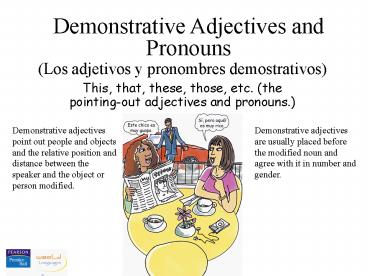Demonstrative adjectives and pronouns - PowerPoint PPT Presentation
1 / 20
Title: Demonstrative adjectives and pronouns
1
Demonstrative Adjectives and Pronouns
(Los adjetivos y pronombres demostrativos)
This, that, these, those, etc. (the pointing-out
adjectives and pronouns.)
Demonstrative adjectives point out people and
objects and the relative position and distance
between the speaker and the object or person
modified.
Demonstrative adjectives are usually placed
before the modified noun and agree with it in
number and gender.
2
este
Este refers to a masculine singular noun that is
close to the speaker.
Este libro que yo tengo aquí es una novela.
3
ese
Ese refers to a masculine singular noun that is
close to the listener.
De qué materia es ese libro que tú tienes allí?
Es de matemáticas.
4
aquel
Aquel refers to a masculine singular noun that is
far from both the speaker and the listener.
Aquel libro que está allá en la mesa es un
diccionario, no?
Exacto!
5
estos
Estos refers to a masculine plural noun that is
close to the speaker.
Estos libros los debo devolver a la biblioteca.
Notice that the plural of este is estos, not
estes.
6
esos
Esos refers to a masculine plural noun that is
close to the listener(s).
Esos libros son interesantes?
Sí, estos libros son muy buenos!
Sí, mucho!
Notice that the plural of ese is esos, not eses.
7
aquellos
Conocen Uds. a las chicas que leen aquellos
libros?
Aquellos refers to a masculine plural noun that
is far from both the speaker and the listener(s).
No, no las conozco.
Yo tampoco.
8
esta
Esta refers to a feminine singular noun that is
close to the speaker.
Esta mochila es muy bonita!
9
esa
Esa refers to a feminine singular noun that is
close to the listener.
Esa mochila no es tan grande como esta mochila.
No, pero es más barata.
10
aquella
Aquella refers to a feminine singular noun that
is far from both the speaker and the listener.
Aquella mochila es muy similar a esta mochila.
Sí, es idéntica.
11
estas
Estas refers to a feminine plural noun that is
close to the speaker.
De quiénes son estas mochilas, me pregunto?
12
esas
Esas refers to a feminine plural noun that is
close to the listener(s).
Esas mochilas son suyas, verdad?
Sí, son nuestras.
Por supuesto.
13
aquellas
Aquellas refers to a feminine plural noun that is
far from both the speaker and the listener(s).
Aquellas mochilas y éstas deben estar perdidas,
yo creo.
No sé de quiénes son.
De acuerdo.
14
Summary
- Este, esta this
- Estos, estas these
- Ese, esa that
- Esos, esas those
- Aquel, aquella that (over there)
- Aquellos, aquellas those (over there)
Here are some memory devices that may help
This and these have ts that and those dont.
1
If it has a t, its close to me.
2
If it has a t, then its touchable.
3
15
Summary
It should be pointed out that, in actual usage,
ese, esa, esos and esas (that, those) are often
used instead of aquel, aquella, aquellos and
aquellas (that over there, those over there),
particularly if the object or person being
referred to is relatively close.
Esa (aquella) muchacha es mi prima, Isabel.
That girl is my cousin, Isabel.
However, if the object or person is quite far
away, the aquel forms are preferred.
Aquella casa allí en el cerro es de mi tío.
That house over there on the hill is my uncles.
16
The Demonstrative Pronouns
(Los pronombres demostrativos)
The forms that take the place of nouns.
17
Notice that, in this scene, the speakers are
referring to the hats but have omitted the word
sombrero, which now turns aquél and éste into
pronouns.
In English, the man would say I like that one a
lot. and his friend would say Umm . . . and
this one?
When written, these pronominal forms bear an
accent on the stressed e.
18
Summary
- éste, ésta this one
- éstos, éstas these (ones)
- ése, ésa that one
- ésos, ésas those (ones)
- aquél, aquélla that one (over there)
- aquéllos, aquéllas those (ones) (over there)
19
esto, eso, aquello
The neuter forms esto, eso, and aquello do not
take a written accent nor do they have plural
forms. They are used to point out ideas, actions
or concepts, or to refer to unspecified objects
or things.
Aquello no me gusta.
I dont like that (business, matter).
No dije eso.
I didnt say that.
Esto está mal.
This is wrong.
These forms are also used to ask for a definition
of something.
Qué es eso?
What is that?
Es una biblioteca.
Its a library.
Qué es esto?
What is this?
Es una pulsera.
Its a bracelet.
20
FIN































